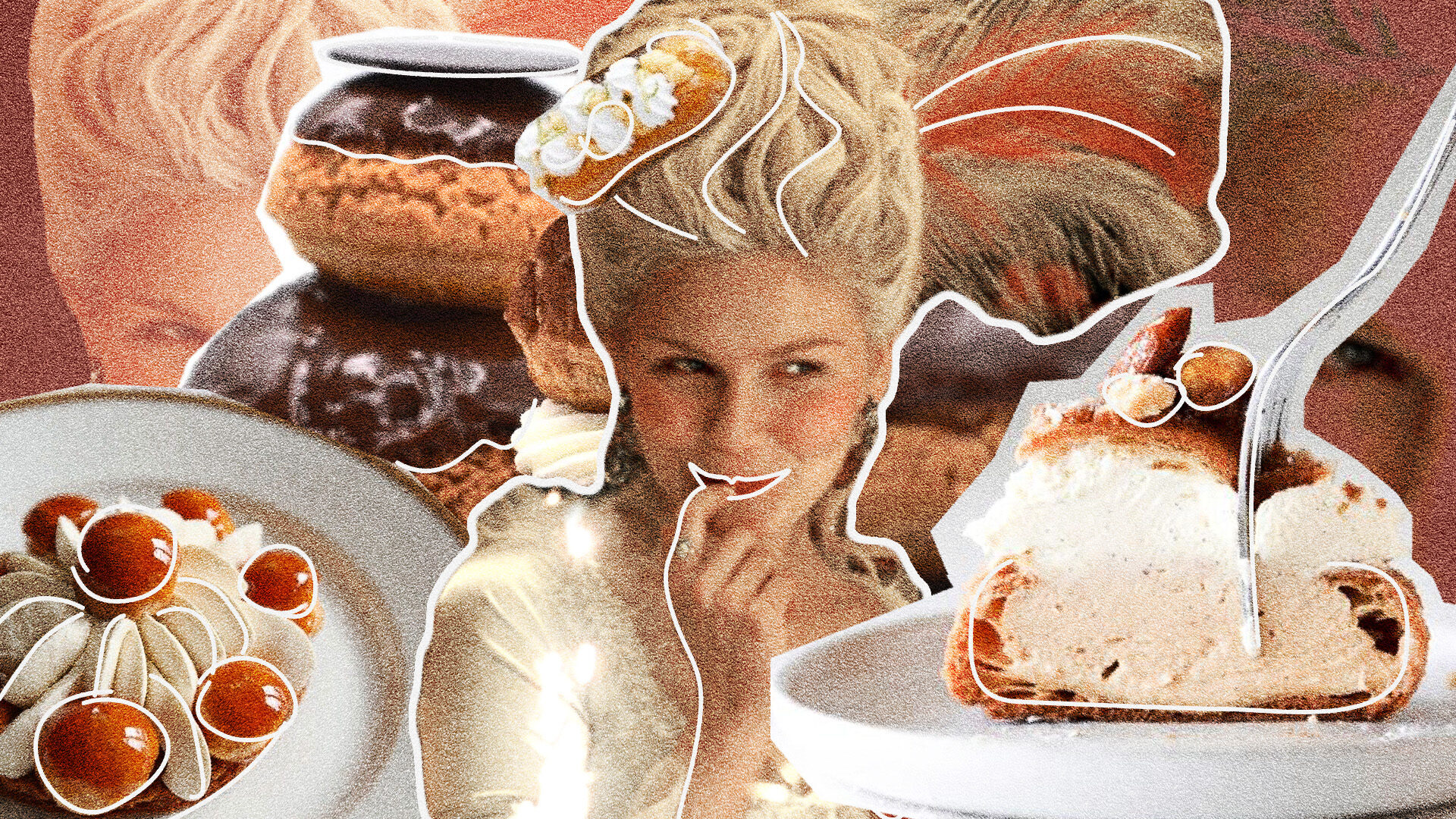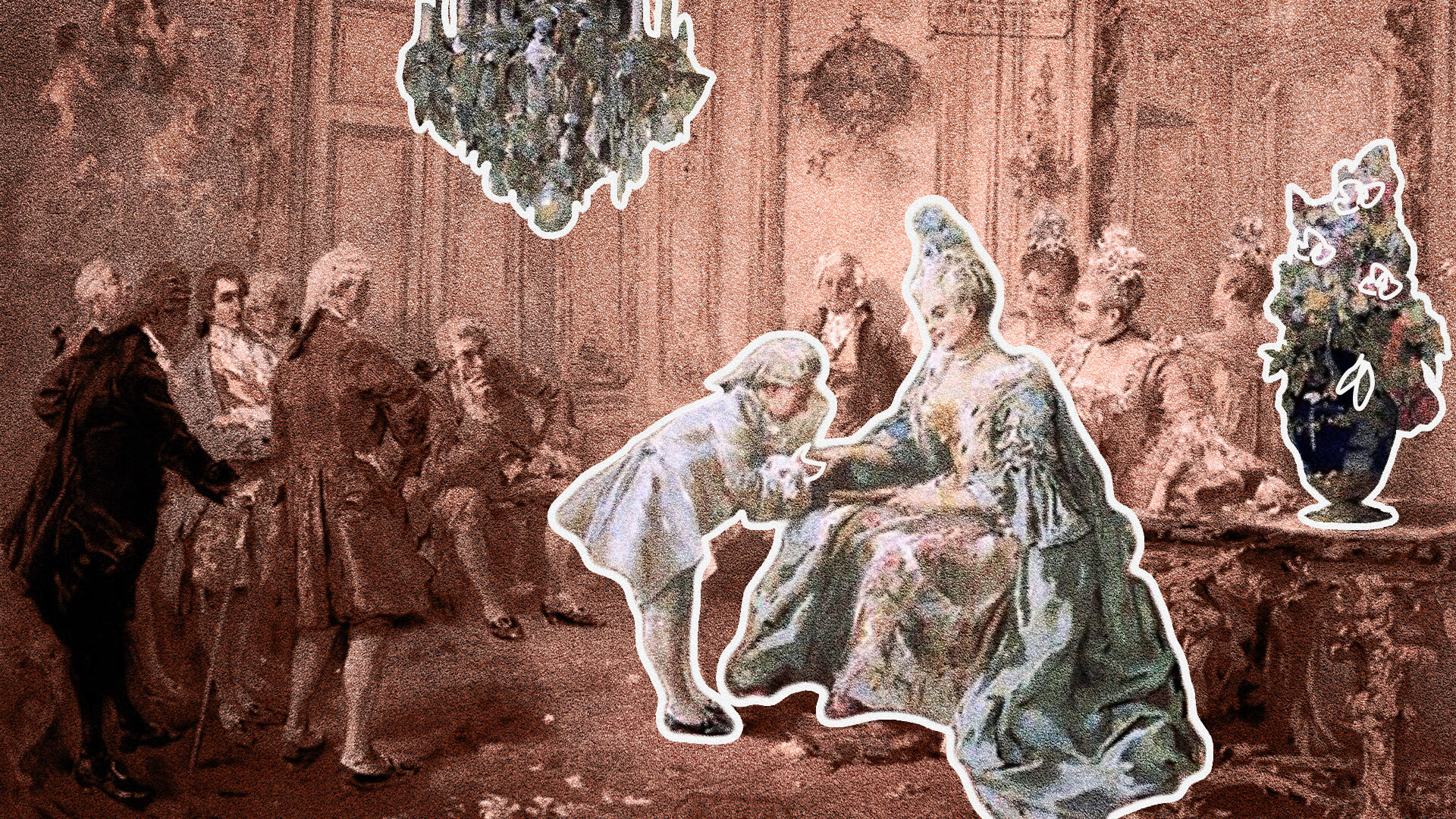At a teatime with Marie Antoinette
Delighting the palate of you, gou gou readers, is a passion of ours and garnishing your days with gourmode anecdotes, is a speciality.
Creamy and tasty fantasies will accompany us on this exquisitely flavoured journey, between tastings and mouth-watering bites of French pastry, while imagining sitting on soft blue armchairs in the hall of mirrors, in front of an irresistible pastry in the company of our friend Marie Antoinette.

We begin by telling you to dream in between buttercream frills, retro bows, and pastel colours. What is coming up in your mind?
In our aid, with a sac à poche in hand, comes the recipe book of the English pastry chef Joseph Lambeth, creator of the most in-vogue cake of today. Everyone, including us, would like to taste a tuft of delicacy by pleasantly dipping our fingers in the soft bento cake known as retro cake for shape and colour that recalls the sweets of the time of our dear ancestor Marie Antoinette!


Take notes if you would like to try your hand at creating a sweet work of art:
- sponge cake base;
- filling of your choice from chantilly cream with fruit, chocolate mousse “diplomatica”, mascarpone with raspberry jelly;
- buttercream and royal icing in abundance for covering;
- decorations are up to you but require manual work of great precision.
Trusting their gourmet taste, we hope to have soon an opportunity to share it with all of you at tea time – the Mami Louise Milano team thought of a bento cake to be dedicated to us. A small and unique secret that we will keep as the last treat of the glove box in view of a special event that we will tell you about soon!
…. In the meantime, speaking of delicacies and royal courtyards, our gourmet à la mode itinerary among our favourite French desserts continues! Psss: we’d love to tell you everything right away! but before you continue reading and let us tell you that Italians have always been gourmands on the culinary podium, do you know why?
Probably some of you already knew about it, the nice and round macaron was born in Italy. Ancient sources date it back to the Venice of the sixteenth century and it would have arrived in France thanks to Caterina de’ Medici, married to the Duke of Orleans Henry II of France in 1533. It was her commissioning it to an Italian confectioner for an important event and therefore to spread it. Its name probably derives from the Italian dialectal word “maccarone” (macaroni), a recognisable pastry made of two soft and coloured meringues enclosing a creamy filling of different tastes and colours. In the beginning, it was just an amaretto cookie, the recipe varied over the years, from one baker to another; in the nineteenth century, it was served two by two with the addition of jams, liqueurs and spices. It became as we know it today in 1930 thanks to Pierre Desfontaines of the Parisian patisserie Ladurée. It was his brilliant idea to take two macaron shells and join them with a delicious ganache cream as a filling; since then, the recipe has never changed.
We are the queens of pastries and mixtures, here we offer you another sweet taste during our afternoon tea, in the mansion where we are guests, the royal palace of Versailles.

We have often wondered about the origin of the names of pastries, our curiosity has been kidnapped by the religieuse, created in 1855 in Paris by a Neapolitan ice cream maker in his pastry shop in boulevard Montmartre, chez Frascati. At the time, however, it had a different shape from the one we know today. It was a simple square of pâte à choux filled with custard and decorated with whipped cream. Later, it became rounder, resembling a large frosted chou filled with custard or Chiboust. Someone as a joke then added a smaller chou by way of a little head and swirls of buttercream between the two choux, to mimic a collar. It is thought that the name of these pastries is due to the colour of the icing, which resembled that of the nuns’ robes.
And speaking of pâte à choux or hot paste, this particular ingredient is used for the preparation of another dessert that we are sure you love as much as we do: the cream puff or bignè.
The etymology of the name could mislead us, but the recipe of choux pastry seems to have been born during the Renaissance at the court of Florence, to be then exported in France in the middle of the sixteenth century by the cooks following Catherine de’ Medici, apparently a lover of pastry. The paternity of the preparation is attributed to the chief pastry chef of Medici Penterelli, perfected by his successor Popelini. Only at the beginning of the nineteenth century, it was perfected with the filling of custard or chantilly cream by Jean Avice and Marie-Antoine Carême becoming a fabulous cream puff. In French the term “choux” means “little cabbage”, in fact, the shape of the cream puffs resembles that of Brussels sprouts.

As true gou gou inspectors and faithful supporters of the sweet taste, we were curious to know every declination in the use of this particular pâte à choux, and spoon in hand, the famous paste is the mother of another cake dear to us: the Saint Honoré. The inventor of this famous cake was a pastry chef named Fauvel Chiboust, who had his business in Rue du Faubourg Saint-Honoré in Paris and who, in 1846, decided to create this preparation in order to honour the saint, Saint Honoré, bishop of Amiens in the VI century, patron of bakers and pastry chefs. The filling that makes this cake so special is Chiboust cream, a base of custard and meringue to which was also added some gelatine for better stability, guaranteeing its success.
The last cream puff on our snack tray today is the éclair or French-style cream puff. This work was as well of Italian pastry chef Popelini, a master at the court of Catherine de’ Medici, who has since entered history with the name pronounced in the French manner, Popelinì. However, it was not until the eighteenth century, that another pastry chef, Antonin Carême, thought it best to refine the recipe and to use pâte à choux to create the modern éclair. Carême used the hot paste to make elongated pastries, filled them with custard and covered them with icing: all of a sudden, éclair was born.
Between sugar, icing, and creams, we have gladdened your thoughts with sweetness, you certainly do not think that this riot of goodness will remain between the lines of our Gourmode Gazette!
We are now ready to put together for you the addresses of the best pastry shops and exceptional French bakeries in our favourite cities to offer you the luxury of tasting gourmode delicacies, dreaming, between one bite and another of teatime at the Palace of Versailles together with Marie Antoinette!
Soon a new mouth-watering appointment will give you an appetite for more…
You may also
be interested in


 Gourmode
Gourmode
